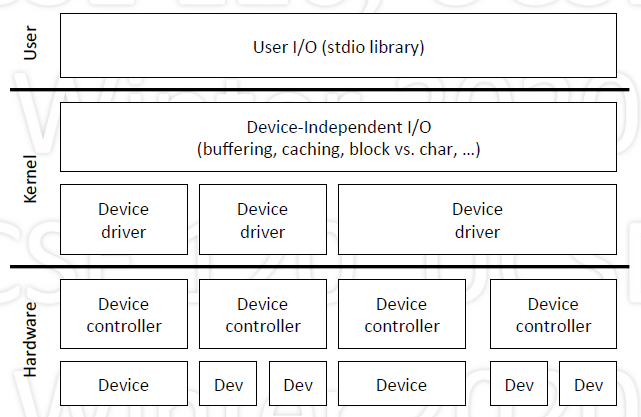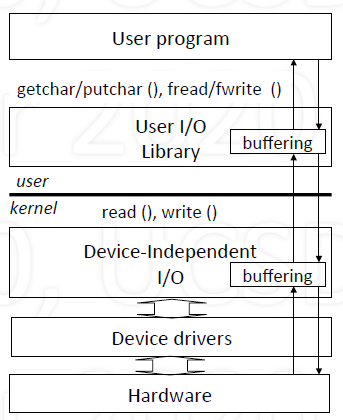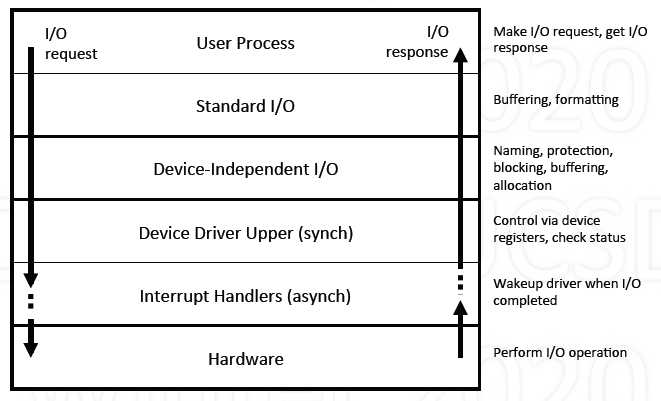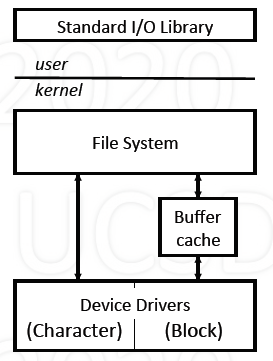本文是我在上UCSD的 CSE 120: Principles of Operating Systems (Winter 2020) 整理的笔记,这一课主要介绍了操作系统里面输入系统系统的概念,包括硬件上的组成以及软件的结构。
I/O basic
Intro
I/O = Input/Output
- Input from attached device to CPU/memory
- Output from CPU/memory to device
Synchronization and transferring data
Issues
Problems:
- So many different types of I/O devices
- Wide range: speed, operation, data transfer units
Questions:
- How does a process initiate I/O?
- How is synchronization achieved?
- How is data transferred?
Background: I/O Hardware
CPU and device (controller) communicate via
- I/O instructions
- Memory instructuions (memory-mapped)
Data transfer: progammed I/O vs. DMA (direct memory access)
Synchronization: polling vs. interrupts

Buffered/Unbuffered I/O
Pros:
- What if pages containing buffer are paged out?
- What if entire process is swapped out?
- Can pin pages, but if too many processes do this?
Cons:
- Memory copying is expensive
- Consider effect on caches
Dealing with Complexity of Devices
Many different types of devices
- Classify by shared characteristics
- Imposes structure: shared code, lower complexity
Dimensions
- Varaible vs. fixed size units
- Sequential vs. random-access
- Synchronous vs. asynchronous
- Speed of operation
I/O system
I/O system Intro
Software that deals with I/O
- Mostly in the kernel
- Also in processes (in form of library, e.g., stdio)
Separated into two portions
- Device-dependent
- Device- independent
Structure: Layered

Device Dependent: Device Drivers
Encapsulates device-dependent code
- Contains device-specific register reads/write
Implements a standard interface
- open(), close(), read(), write()
Interrupt handlers
- Executes when I/O completes
- Updates data structure
- Wakes up waiting process
Device-Independent I/O
- Uniform interfacing for device drivers
- Naming, protection
- Uniform block size
- Buffering, caching
- Storage allocation
- Locking
- Error handling
User-space I/O

Convenient interface
- printf() vs. write()
User-level buffering
- Unix: stdio library
Spooling daemons
- Printer
Overall Operation

Example: UNIX
I/O Model

- Uses file system interface
- stdio.h: C standard I/O library
Block devices (disks, USB cameras, …)
- Fixed-size blocks
- Randomly addressable
- Uses buffer cache
Character devices (serial ports, parallel ports, sound cards,…)
- Variable sequence of bytes
- For non-block devices
I/O System Call Interface
- fd = open(“/dev/devname”, …)
- close(fd)
- nr = read(fd, buf, n)
- nw = write(fd, buf, n)
- ioctl(fd, cmd, buf) //(input/output control)
Standard I/O Library
- fopen, fread, fwrite, fprintf, fscanf, fclose, …
- Private buffer kept in user space
- Minimizes the number of I/O system calls
Software Block Cache Design
- Has copies of blocks that are also on disk
Upon read or write
- Check if a buffer contains the block
- If not, get from disk
- To make room, remove LRU block